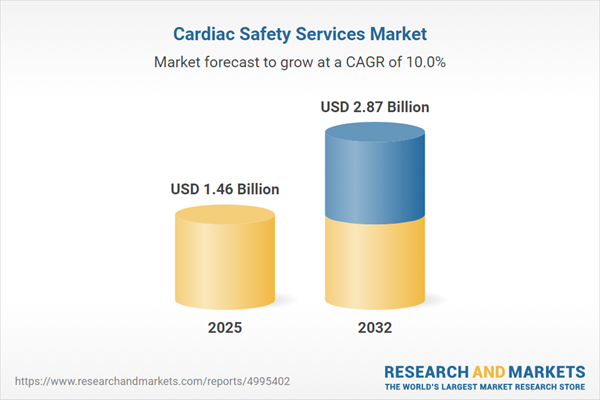Speak directly to the analyst to clarify any post sales queries you may have.
The cardiac safety services market is entering a pivotal phase shaped by regulatory changes and advancing digital health technologies. Senior decision-makers must understand shifting industry dynamics, evolving compliance needs, and new technological enablers in cardiovascular safety assessments to make informed choices in this fast-evolving sector.
Market Snapshot: Cardiac Safety Services Market Trends
The cardiac safety services market grew from USD 1.33 billion in 2024 to USD 1.46 billion in 2025 and is projected to continue expanding at a CAGR of 10.03%, reaching USD 2.87 billion by 2032. This trajectory reflects the rising emphasis on early cardiac signal detection, clinical trial complexity, and increasing demand for integrated monitoring and diagnostic solutions. As regulatory environments intensify and the need for end-to-end cardiac assessment grows, industry providers are investing in comprehensive solutions that span diagnostics, risk modeling, and advanced data analytics.
Scope & Segmentation
- Service Types: Blood pressure measurement, cardiovascular imaging, ECG/Holter monitoring, thorough QT studies
- Service Models: Integrated solutions delivering multiple diagnostic modalities, as well as standalone service offerings
- Applications: Drug and device development, as well as regulatory compliance for market submissions
- End Users: Contract research organizations, pharmaceutical and biopharma companies, academic and private research institutes
- Technology Focus: Advanced digital monitoring platforms, AI-driven analytics, remote acquisition, interoperability frameworks, next-generation imaging methods, and machine learning-based risk assessment
- Geographic Markets: Americas (including North America and Latin America), Europe, Middle East & Africa (key national and subregional centers), Asia-Pacific (notably China, India, Japan, Southeast Asia, and leading regional economies)
- Key Industry Players: Market leaders and innovators such as ACM Global Laboratories, Advarra, Inc., Banook Group, Biotrial, Celerion, Clario, Charles River Laboratories, Circle Cardiovascular Imaging, Eurofins Scientific, ICON PLC, IQVIA Holdings, GE HealthCare Technologies, and others
Key Takeaways: Strategic Insights for Decision-Makers
- Market demand is increasing for end-to-end cardiac safety assessment programs as sponsors and CROs seek unified protocols across trials, accelerating decision-making and regulatory approval processes.
- Technological transformation is redefining industry standards, with cloud-based ECG analytics, AI-powered arrhythmia detection, wearable devices, and real-time remote monitoring supporting advanced risk stratification.
- Stringent and harmonized regulations are fostering more standardized data management and cross-border collaboration, prompting agile adaptation among market participants and streamlining digital submission for compliance.
- Strategic alliances between contract research organizations, device manufacturers, and imaging specialists are enabling co-development of proprietary platforms for improved service quality and operational resilience.
- Providers able to demonstrate robust supply chains, transparent cost structures, and resilience to economic pressure are increasingly preferred by sponsors seeking risk mitigation in light of volatile global trade conditions.
Tariff Impact: Market Adjustments Following U.S. Trade Changes
Newly implemented U.S. tariffs have introduced cost pressures in cardiac safety service supply chains, particularly for specialized imported equipment and consumables. In response, providers are prioritizing domestic sourcing, renegotiating supplier agreements, and adopting workflow redesigns to minimize reliance on tariff-affected goods. These efforts support cost stability and maintain service quality, positioning firms to reassure sponsors of continuity and transparency despite ongoing economic volatility.
Methodology & Data Sources
This market analysis leverages expert interviews with leaders across contract research organizations, pharmaceutical sponsors, and academic institutes. Primary insights are triangulated with regulatory reviews, patent analytics, and public financial filings to ensure the highest level of data integrity and accuracy. Robust cross-functional quality checks further validate the findings throughout the report.
Why This Report Matters
- Supports executive-level strategy with actionable insight into evolving technology, compliance drivers, and supplier risks across global cardiac safety services.
- Enables procurement optimization, partner selection, and competitive benchmarking based on transparent analysis of operational and innovation trends by segment and region.
Conclusion
The cardiac safety services market is being transformed by regulatory harmonization, advanced monitoring platforms, and ongoing economic pressures. Organizations that invest in integrated digital solutions and resilient partnerships will be best placed to achieve operational excellence and meet future cardiac safety needs.
Additional Product Information:
- Purchase of this report includes 1 year online access with quarterly updates.
- This report can be updated on request. Please contact our Customer Experience team using the Ask a Question widget on our website.
Table of Contents
3. Executive Summary
4. Market Overview
7. Cumulative Impact of Artificial Intelligence 2025
Companies Mentioned
The companies profiled in this Cardiac Safety Services market report include:- ACM Global Laboratories
- Advarra, Inc.
- Banook Group
- Biotrial
- Celerion
- Certara, Inc.
- Charles River Laboratories International, Inc.
- Circle Cardiovascular Imaging Inc.
- Clario
- Clyde Biosciences Limited
- Eurofins Scientific SE
- GE HealthCare Technologies Inc.
- ICON PLC
- IQVIA Holdings Inc.
- Koninklijke Philips N.V.
- Laboratory Corporation of America Holdings
- Medpace, Inc.
- MERIT CRO, Inc.
- Metrion Biosciences Limited
- Ncardia Services B.V.
- NEXEL Co., Ltd.
- Octagos Health, Inc.
- Parexel International Corporation
- PhysioStim SAS
- PPD, Inc. by Thermo Fisher Scientific Inc.
- Richmond Pharmacology Limited
- Shanghai Medicilon Inc.
- Worldwide Clinical Trials
Table Information
| Report Attribute | Details |
|---|---|
| No. of Pages | 183 |
| Published | November 2025 |
| Forecast Period | 2025 - 2032 |
| Estimated Market Value ( USD | $ 1.46 Billion |
| Forecasted Market Value ( USD | $ 2.87 Billion |
| Compound Annual Growth Rate | 10.0% |
| Regions Covered | Global |
| No. of Companies Mentioned | 29 |









